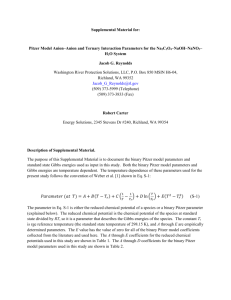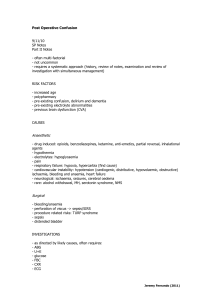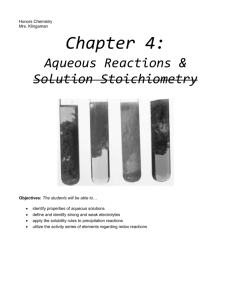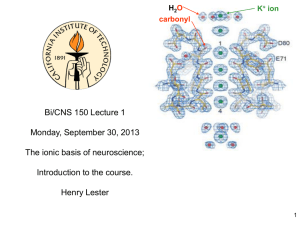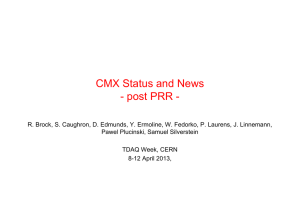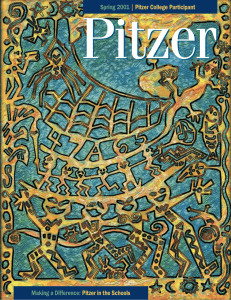Electronic Supplementary Material Accreditation and Quality
advertisement
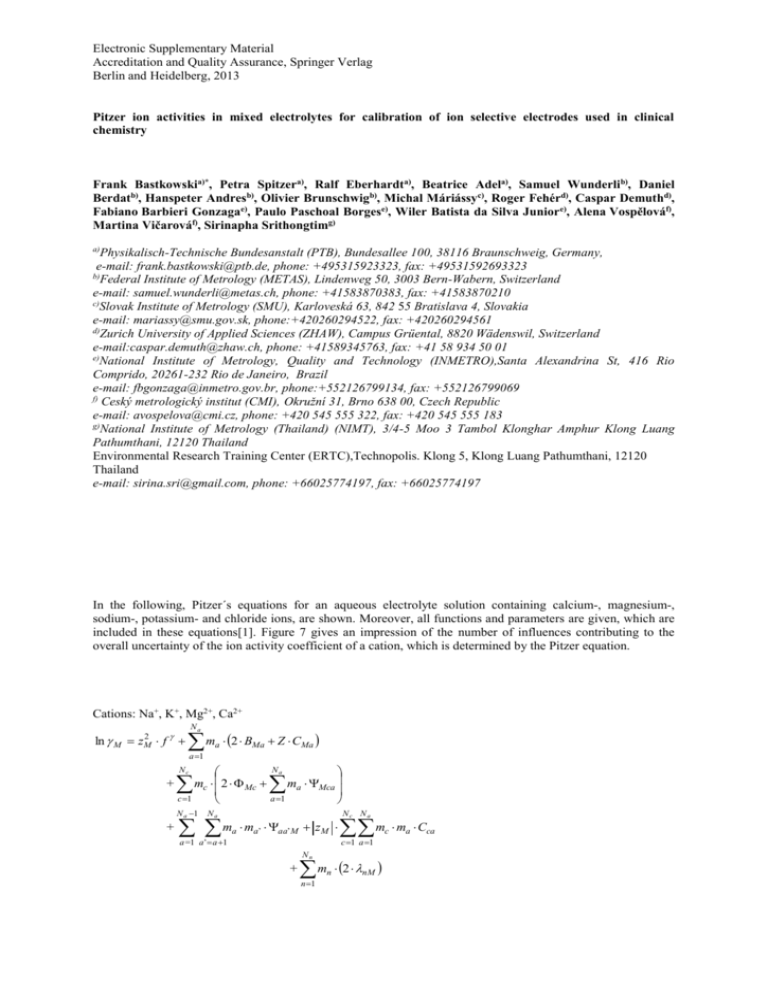
Electronic Supplementary Material Accreditation and Quality Assurance, Springer Verlag Berlin and Heidelberg, 2013 Pitzer ion activities in mixed electrolytes for calibration of ion selective electrodes used in clinical chemistry Frank Bastkowskia)*, Petra Spitzera), Ralf Eberhardta), Beatrice Adela), Samuel Wunderlib), Daniel Berdatb), Hanspeter Andresb), Olivier Brunschwigb), Michal Máriássyc), Roger Fehérd), Caspar Demuthd), Fabiano Barbieri Gonzagae), Paulo Paschoal Borgese), Wiler Batista da Silva Juniore), Alena Vospělováf), Martina Vičarováf), Sirinapha Srithongtimg) a) Physikalisch-Technische Bundesanstalt (PTB), Bundesallee 100, 38116 Braunschweig, Germany, e-mail: frank.bastkowski@ptb.de, phone: +495315923323, fax: +49531592693323 b) Federal Institute of Metrology (METAS), Lindenweg 50, 3003 Bern-Wabern, Switzerland e-mail: samuel.wunderli@metas.ch, phone: +41583870383, fax: +41583870210 c) Slovak Institute of Metrology (SMU), Karloveská 63, 842 55 Bratislava 4, Slovakia e-mail: mariassy@smu.gov.sk, phone:+420260294522, fax: +420260294561 d) Zurich University of Applied Sciences (ZHAW), Campus Grüental, 8820 Wädenswil, Switzerland e-mail:caspar.demuth@zhaw.ch, phone: +41589345763, fax: +41 58 934 50 01 e) National Institute of Metrology, Quality and Technology (INMETRO),Santa Alexandrina St, 416 Rio Comprido, 20261-232 Rio de Janeiro, Brazil e-mail: fbgonzaga@inmetro.gov.br, phone:+552126799134, fax: +552126799069 f) Ceský metrologický institut (CMI), Okružní 31, Brno 638 00, Czech Republic e-mail: avospelova@cmi.cz, phone: +420 545 555 322, fax: +420 545 555 183 g) National Institute of Metrology (Thailand) (NIMT), 3/4-5 Moo 3 Tambol Klonghar Amphur Klong Luang Pathumthani, 12120 Thailand Environmental Research Training Center (ERTC),Technopolis. Klong 5, Klong Luang Pathumthani, 12120 Thailand e-mail: sirina.sri@gmail.com, phone: +66025774197, fax: +66025774197 In the following, Pitzer´s equations for an aqueous electrolyte solution containing calcium-, magnesium-, sodium-, potassium- and chloride ions, are shown. Moreover, all functions and parameters are given, which are included in these equations[1]. Figure 7 gives an impression of the number of influences contributing to the overall uncertainty of the ion activity coefficient of a cation, which is determined by the Pitzer equation. Cations: Na+, K+, Mg2+, Ca2+ 2 ln M z M f Na m a 2 BMa Z CMa a 1 Na mc 2 Mc ma Mca c 1 a 1 Nc + N a 1 + Na ma ma’ aa’M z M a =1 a’ a 1 Nc Na m m c c 1 a 1 Nn + m n n 1 2 nM a Cca Anion: Cl ln X z 2X f Nc m 2 B c cX Z CcX c 1 Nc ma 2 Xa mc Xac a 1 c 1 Na + N c 1 N c + mc mc’ cc’ X z X Nc Na m m c a Cca c 1 a 1 c =1 c’ = c +1 Nn + m n 2 nX n 1 Hückel-Term for electrostatic long-range interaction between solution species: 1 1 I2 2 f A ln 1 1.2 I 2 1 2 1.2 1 1.2 I Nc Na mc ma B 'ca N c 1 N c c 1 a 1 mc mc’ 'cc’ N a 1 Na m a ma’ 'aa’ a =1 a’ a 1 c =1 c’ = c +1 C-Term independent of ionic strength CMX CMX 2 zM z X 1 2 from Pitzer-Tables C MX Z z i mi I i 1 2 z 2 i mi ionic strength i A Hückel-Parameter is one third the debye-Hückel limiting slope: 1 e2 A 2 N A d w 1 / 2 0 3 4 ( H 2O) k T 3/ 2 Am Hückel-Parameter Am A 3 ln 10 Density of water d w t a1 2 t a2 d w a5 1 (cf. literature [2]) a3 t a4 a1 -3.983035 0.00067 C a2 301.797 C a3 522528.9C2 a4 69.34881 C a5 999.974950 0.00084 kg m-3 -2/6- Relative permittivity of water ( H 2O) (cf. literature [3]) (H 2O) c1+c2 t 273 .15C +c3 t 273 .15C 2 t: absolute temperature in °C c1 249 .21 c2 0.79069 C 1 c3 0.72997103 C 2 B-functions (depending on ionic strength): 0 1 exp I 2 exp I BMX MX MX 1 MX 2 0 1 g I 2 g I BMX MX MX 1 MX 2 1 2 B'MX MX g ' 1 I / I MX g ' 2 I / I For 1:1, 1:2 or 2:1 electrolytes, respectively: ( 1 2, 2 0, (2) 0 ) 0 1 exp 2 I BMX MX MX 0 1 g 2 I BMX MX MX B'MX 1 g ' 2 I / I MX For 2:2 electrolytes: ( 1 1.4, 2 12, (2) 0 ) 0 1 exp 1.4 I 2 exp 12 I BMX MX MX MX 0 1 g 1.4 I 2 g 12 I BMX MX MX MX 1 2 B'MX MX g ' 1.4 I / I MX g ' 12 I / I x i I argument for g- and g'-functions 1 2 for pairs in which cation or anion is univalent, 2 0 1 1.4 for higher valence pairs, 2 12 g x 2 1 1 x e x / x2 x2 g ' x 2 1 1 x e x / x 2 2 0, 1, 2 from Pitzer-Tables (cf literature [4]), mostly 2 0 is zero for pairs with one univalent ion Temperature dependence of -parameters used: 1 1 T 0 q1 q2 q3 ln q4 T T0 q5 T 2 T02 T T0 T0 q1 q2 q3 q4 q5 Na+Clˉ 0.0765 -777.03 -4.4706 0.008946 -3.3158E-6 K+Clˉ 0.04835 0 0 5.794E-4 0 Mg2+Clˉ 0.35235 0 0 -1.943E-4 0 Ca2+Clˉ 0.3159 0 0 -1.725E-4 0 -3/6- 1 1 q6 q7 q6 Na+Clˉ 0.2664 K+Clˉ 0.2122 Mg2+Clˉ 1.6815 Ca2+Clˉ 1.614 q7 0 0 0 0 T T 1 q8 ln q9 T T0 q10 T 2 T02 T T0 0 q8 0 0 0 0 q9 6.1608E-5 10.71E-4 3.6525E-3 3.9E-3 q10 1.0715E-6 0 0 0 T0=298.15 K 2 is considered to be zero in case of 1:1, 1:2 ions Temperature dependence of C-parameters: 1 1 T CMX q16 q17 q18 ln q19 T T0 T T 0 T0 q16 q17 q18 q19 Na+Clˉ 0.00127 33.317 0.09421 -4.655E-5 K+Clˉ -0.00084 0 0 -5.095E-5 Mg2+Clˉ 0.00519 0 0 -1.649333E-4 Ca2+Clˉ -0.00034 0 0 6.213E-5 CMX CMX 2 zM z X 1 2 from Pitzer-Tables (cf. above) CMX Ion interaction approach: Theory and data correlation, Chapter 3, K.S. Pitzer, p.75-129 Activity coefficients in electrolyte solutions 2nd ed. (cf. literature [5]) Second virial coefficients ij , ij , 'ij are dependent mainly of ionic strength: Theta parameter values for cation-cation´ respectively anion-anion´ interactions ij ij E ij I I E 'ij I ij ij E ij I 'ij E 'ij I ij ij I 'ij I ij from Pitzer-Tables ij -values (cation-cation´ respectively anion-anion´): Na+K+ Na+ Mg2+ Na+Ca2+ K+Mg2+ K+Ca2+ Mg2+Ca2+ -0.012 0.07 0.07 0.0 0.032 0.007 xMN 6 zM z N A I arguments for J-functions (Integrals) MN I is a function of the ionic strength and electrolyte pair type and is nonzero only for non-symmetric electrolytes (e.g.1-2 types). E -4/6- zM z N J 0 xMN 12 J 0 xMM 12 J 0 xNN 4 I E z z MN E 'MN I M 2N J1 xMN 12 J1 xMM 12 J1 xNN I 8 I E MN I J1 xMN is the derivative of the function J 0 xMN with respect to xMN J-integrals for J 0 x 14 x 1 J1 x 14 x 1 x 1 exp y e 0 x y y 2 dy x 1 x 1 1 e y exp e y y 2dy x y y 0 xNaNa 6 1 1 A I xNaK 6 1 1 A I xNaMg 6 1 2 A I xNaCa 6 1 2 A I xKK 6 1 1 A I xKMg 6 1 2 A I xKCa 6 1 2 A I xMgMg 6 2 2 A I xMgCa 6 2 2 A I xCaCa 6 2 2 A I xClCl 6 1 1 A I Fig. 5 Cause and effect diagram for the Pitzer single ion activities of a cation in a complex electrolyte mixture (cf. Appendix). For each influence parameter a standard uncertainty is attributed to the value. The uncertainties of the Pitzer parameters were estimated type B uncertainties. All coefficients of the model equations (water density, -5/6- water relative permittivity with its temperature dependence, temperature dependence of the Pitzer parameters including constants such as the Avogadro and Boltzmann constant, etc.) were included with their uncertainties. References 1. Harvie CE, Møller N, Weare JH (1984) The prediction of mineral solubilities in natural waters: The Na-KMg-Ca-H-CI-SO4-OH-HCO3-CO3-CO2-H2O system to high ionic strengths at 25°C Geochimica et Cosmochimica Acta 48:723-751 2. M. Tanaka, G. Girard, R. Davis, A. Peuto, Bignell N (2001) Recommended table for the density of water between 0 °C and 40 °C based on recent experimental reports. Metrologia 38:301-309 3. D.R. Lide (1995) CRC Handbook of Chemistry and Physics. 76th edn. CRC Press, Boca Raton, FL 4. Pitzer KS, Mayorga G (1973) Thermodynamics of Electrolytes. I I. Activity and Osmotic Coefficients for Strong Electrolytes with One or Both Ions Univalent. J Phys Chem 77:2300-2308 5. Pitzer KS (1974) Thermodynamics of Electrolytes. III. Activity and Osmotic Coefficients for 2-2 Electrolytes. Journal of Solution Chemistry 3:539-546 -6/6-
